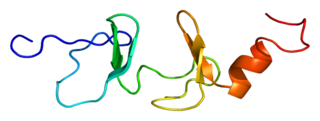
Histone deacetylase 1 (HDAC1) is an enzyme that in humans is encoded by the HDAC1 gene.

The nuclear receptor co-repressor 1 also known as thyroid-hormone- and retinoic-acid-receptor-associated co-repressor 1 (TRAC-1) is a protein that in humans is encoded by the NCOR1 gene.

The nuclear receptor co-repressor 2 (NCOR2) is a transcriptional coregulatory protein that contains several nuclear receptor-interacting domains. In addition, NCOR2 appears to recruit histone deacetylases to DNA promoter regions. Hence NCOR2 assists nuclear receptors in the down regulation of target gene expression. NCOR2 is also referred to as a silencing mediator for retinoid or thyroid-hormone receptors (SMRT) or T3 receptor-associating cofactor 1 (TRAC-1).

In the field of molecular biology, a corepressor is a molecule that represses the expression of genes. In prokaryotes, corepressors are small molecules whereas in eukaryotes, corepressors are proteins. A corepressor does not directly bind to DNA, but instead indirectly regulates gene expression by binding to repressors.

Histone deacetylase 2 (HDAC2) is an enzyme that in humans is encoded by the HDAC2 gene. It belongs to the histone deacetylase class of enzymes responsible for the removal of acetyl groups from lysine residues at the N-terminal region of the core histones. As such, it plays an important role in gene expression by facilitating the formation of transcription repressor complexes and for this reason is often considered an important target for cancer therapy.

Histone deacetylase 3 is an enzyme encoded by the HDAC3 gene in both humans and mice.

Paired amphipathic helix protein Sin3a is a protein that in humans is encoded by the SIN3A gene.

Histone deacetylase 4, also known as HDAC4, is a protein that in humans is encoded by the HDAC4 gene.

Four and a half LIM domains protein 2 also known as FHL-2 is a protein that in humans is encoded by the FHL2 gene. LIM proteins contain a highly conserved double zinc finger motif called the LIM domain.

Histone deacetylase 5 is an enzyme that in humans is encoded by the HDAC5 gene.

Metastasis-associated protein MTA2 is a protein that in humans is encoded by the MTA2 gene.

Transcriptional regulator Kaiso is a protein that in humans is encoded by the ZBTB33 gene. This gene encodes a transcriptional regulator with bimodal DNA-binding specificity, which binds to methylated CGCG and also to the non-methylated consensus KAISO-binding site TCCTGCNA. The protein contains an N-terminal POZ/BTB domain and 3 C-terminal zinc finger motifs. It recruits the N-CoR repressor complex to promote histone deacetylation and the formation of repressive chromatin structures in target gene promoters. It may contribute to the repression of target genes of the Wnt signaling pathway, and may also activate transcription of a subset of target genes by the recruitment of catenin delta-2 (CTNND2). Its interaction with catenin delta-1 (CTNND1) inhibits binding to both methylated and non-methylated DNA. It also interacts directly with the nuclear import receptor Importin-α2, which may mediate nuclear import of this protein. Alternatively spliced transcript variants encoding the same protein have been identified.

Homeobox protein Hox-B13 is a protein that in humans is encoded by the HOXB13 gene.

Lysine-specific demethylase 4A is an enzyme that in humans is encoded by the KDM4A gene.

G protein pathway suppressor 2 is a protein that in humans is encoded by the GPS2 gene.

Histone H4 is a protein that in humans is encoded by the HIST1H4F gene.

Histone H4 is a protein that in humans is encoded by the HIST1H4A gene.

Transducin (beta)-like 1X-linked, also known as TBL1X, is a protein which in humans is encoded by the TBL1X gene.

Tripartite motif-containing 33 (TRIM33) also known as transcriptional intermediary factor 1 gamma (TIF1-γ), is a human gene.

Coronin, actin binding protein, 2A is a protein that in humans is encoded by the CORO2A gene.























